Yashica 35
The first of the 35 mm cameras
.jpg)
Contents
Serial Numbers
Production & Trim Variations
Mainstream Mid-range Minister Models
Top Spec Lynx Models
Budget Range
Automation
Arrival
The Yashica 35 was Yashima's first 35 mm camera and the second camera after its Yashica 8 movie camera to tread a different path to its bread and butter 6x6 TLR models which had so far been the source of the company's growth and success. The writing was on the wall for TLRs and Yashima could see that the future looked different.
How this camera was developed is not clear to me. It is often linked to the acquisition of Nicca (May 1958). The Yashica rangefinder camera website Yashica Guy, comments that it “ is the first of the Rangefinder models to have been produced in the integrated Yashica Works”. In one sense, that is likely to be correct but in another, it gives a false impression that Nicca was somehow involved. From serial numbers, it looks like the first production examples rolled off the assembly line in April 1958 already which fits with the April 1958 release claimed in the company's 1975 booklet “Yashica A New Horizon” and Japanese magazine “Camera Collectors' News” of July 1987 and other sources. In other words, Yashima was already making this camera before the arrangement with Nicca came into effect.
Although lacking innovation in comparison to some contemporary models, most commentators regard the Yashica 35 as a well designed, quality camera. To me, it seems like the mature product of a camera maker familiar with 35 mm fixed lens rangefinder cameras so it is quite remarkable for a first up effort, particularly in light of Yashica Guy's claim that the General Manager of the “reorganised company”, Mr Agucho, had a vision of a rangefinder camera “which the masses could afford”.
Clearly, the design, testing and tooling for such a model will have taken some time to execute and its gestation must have occurred well back in 1957, if not earlier. If Yashica had any sort of outside assistance or partnership in the development, it would unlikely have been struggling Nicca as its models had little in common with a rangefinder camera with fixed lens and in-lens leaf shutter.
The Camera
The Yashica 35 is a solidly constructed, substantial, mostly glass and metal full manual camera without exposure meter. Like several other Japanese rangefinders from the period, the handsome overall look of the camera is borrowed from the pre-War German Contax II, or from the Nikon S, take your pick. The Nikon S was a visual copy (and more) of the Contax II in any case. With lever film wind, re-wind knob with folding crank and hinged back, the Yashica 35 is already modern but still uses the sliding latch on the side for opening the back which was common in the 1950s. Very early f/1.9 version pictured with matching lens hood, below it, a relatively late example:
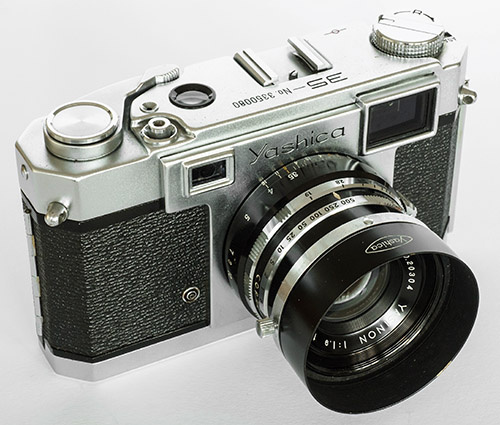
Given Yashima's established focus on quality at the lowest prices (profit through volume) and the vision of this camera as being for the “masses”, Yashima could have been forgiven for some cost cutting with this first model but there is little evidence of that. The coupled rangefinder has a long base and uses superior prisms instead of mirrors. The combined viewfinder/rangefinder window is not parallax corrected but does have a bright frame, already an improvement over most of the more expensive Leica copies available. Frame counting is in a window and resets automatically, not even something carried across into Yashica's first SLRs. The top plate also has a window for setting the DIN/ASA film speed reminder.
Shutter
The between the lens leaf shutter has a full range of speeds from B to 1/500, in most instances using the old speed progression (e.g. 1/25 and 1/50), and also a self-timer. Three examples have been found with the new progression (e.g. 1/30 and 1/60). One is the last f/1.9 version in my database (the SV example from December 1960 immediately below) which makes sense, the other two are f/2.8 versions from much earlier, December 1958 and January 1959. With its TLRs, Yashica seemed to start the transition from the old progression in 1958 but there were still some stragglers in early 1961.
As far as I can make out from references and also photos showing the name on the side of the lens barrel, the between lens leaf shutter is a Copal MXV on all examples of both variants. With front element block removed, this is the shutter cover plate of an early example still with “Yasinon” f/1.9 lens (see further below):
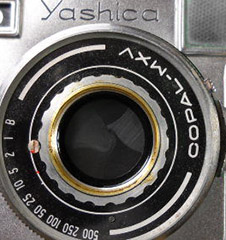 (Detail from larger web image)
(Detail from larger web image)
However, photos of a tear down of an early f/2.8 example clearly show a Copal SV cover plate. This type of cover plate is also found on the very last Yashica 35 with f/1.9 lens in my database from December 1960. The example is owned by contributor Chris Whelan:


(Images courtesy of Chris Whelan)
Correspondent Kirk Thorsteinson has since contacted me with details of his September 1960 camera with f/1.9 lens which also has the SV shutter cover plate. Photos are in Kirk's Flickr site.
With the shutter open on Bulb, the aperture with 10 curved blades is visible which is typical of the Copal MXV and earlier shutters used on Yashica's TLRs. The SV shutters used on Yashica TLRs typically have 5 blades but I'm certain that is not a design absolute, just an optional variation offered by Copal. The two shutters, when configured the same, really are very similar, operate the same way and seem to share parts - see Lenses & Shutters.
Whether these three examples fitted with Copal SV shutters are repair items, part of a larger implementation of the SV shutter or something else, I really have no idea, but if pressed, I would say it's a supply issue and substituting like with like as far as the shutter and camera maker are concerned.
Lenses
Two versions of the Yashica 35 were offered, one with an f/1.9 4.5 cm Yashinon lens and the other with an f/2.8 4.5 cm Yashinon lens. In other respects, the two models were identical. Both lenses are relatively sophisticated for the time, the f/1.9 is 6 elements in 4 groups Planar design and the f/2.8 is 5 elements in 4 groups Xenotar design (5 element version of the original Planar):
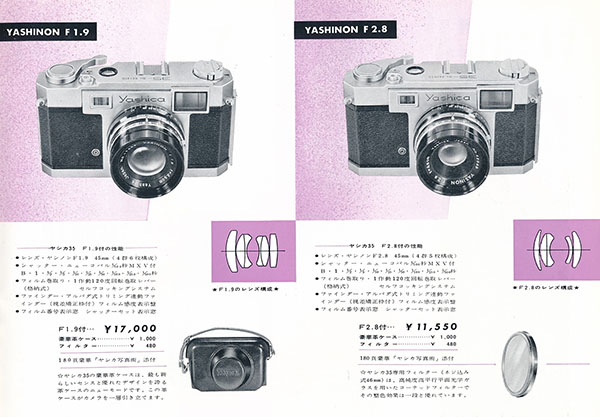 (Scan courtesy of Chris Whelan)
(Scan courtesy of Chris Whelan)
(Click on page for larger version)
That page is taken from this brochure, there are also similar details in a slightly later brochure in which Yashica tells us that both lenses include elements with glass containing lanthanum, a so-called “rare earth”. Lanthanum is often erroneously thought to be radioactive, well it is but at negligible levels, the lenses that do give off measurable radiation and turn yellow contain thorium. Yashica explains that the lens designs and coatings are focused on obtaining optimum results with colour film noting particular concerns about correcting chromatic aberrations and reducing vignetting (light fall-off towards image edges) given the limited exposure latitude of the emulsions of the day.
On the headings, both lenses are called “Yashinon”, however, the name on the front of both lenses is “Yasinon”. There is more here including cine lens examples. Clearly, Yashima had a change of mind. With two exceptions, the only f/2.8 “Yasinon” examples I have seen are in brochures. Paradoxically, the two exceptions are latish examples from May 1959 and March 1960 cameras. However, production versions of the f/1.9 “Yasinon” lens are comparatively common. The majority, but not all, of found examples fitted to the cameras made in the first two months (April and May 1958) are branded “Yasinon” and the odd one or two continue to appear on cameras made up to and including January 1960. All the “Yasinon” f/1.9 lenses have 5 digit serial numbers and the “Yashinon” lenses are 6 digit except the very first one which is 5 digit but higher than all the “Yasinon” types (2228x). The production “Yashinon” f/2.8 lenses start with 5 digits and progress to 6 digits towards the end. The two found “Yasinon” f/2.8 lenses (3200x from 1960 and 3210x from 1959) and the brochure example (32048 from April 1958) have the lowest serial number of any f/2.8 lens . My f/1.9 “Yasinon” from May 1958:

Here it is shown next to my late example (both cameras featured further above, the eagle eyed will note a number of trim differences - these are detailed further below, mostly using these two cameras as examples):

With Zunow cine lens examples and the 13.5 cm LTM telephoto for the YE & YF being being made by Kyoei Optical Co., Ltd., as were almost certainly the 13.5 cm and longer first series (“silver nose”) Pentamatic lenses with the second series T-mount Pentamatic/M42 (“black nose”) lenses perhaps being made by the company that later became Tokina, the idea of Tomioka being the “exclusive” lens maker for Yashica is somewhat discredited. So who made these lenses?
I think that Tomioka still has to be the front runner. Whereas with the other lens formats, there was no history of prior examples, similar focal length and aperture “Tominor” lenses (renamed “Tominon” on some later variants) are found on Royal rangefinder cameras made by Royal Camera Company from 1955 onward. The lens construction of the 45 mm f/1.9 and f/2.8 lenses is not known to me but the earliest model featured an unusually complex 50 mm f/2 lens with 7 elements in 5 groups, or, an f/2.8 lens with 5 elements.
There may be other Tomioka made examples as well. Camera-wiki.org claims that the 5 element “Riken Ricoh” 45 mm f/2.8 lens of the 1957 Ricoh 500 rangefinder camera was made by Tomioka as was the similar spec “Ricomat” of the 1958 second version. There are other suggestions that Tomioka may also have been responsible for the “Canter” and “Biokor” lenses on Beauty cameras including a pair of 45 mm f/1.9 and f/2.8 lenses for 35 mm rangefinder cameras.
Focusing Distance Scales
With lens barrels that pretty much look identical to each other, you would expect the focusing distance scales to be the same too, but no. Right from the beginning, whether “Yasinon” or “Yashinon”, Yashima made or Yashica made, the f/1.9 lenses are marked either “M” or “ft” for metres and feet respectively.
On the other hand, the f/2.8 lenses on the early Yashima made examples are mainly in feet marked “ft”. There is one metric one marked “Meter”. Then when the maker name changed to Yashica, all bar three in my database are now metric, still marked “Meter”, but the three feet scaled exceptions have changed to “feet”.
Dual scale focusing scales, marked “m” (white) and “ft” (yellow), started in November 1959 for the f/1.9 version and early 1960 for the f/2.8 (March by my database but I have no January or February cameras) but the odd single scale camera turns up right to the very end including the very last one in the database (another “ft” from Japan).
Target Markets
It's difficult to draw any real conclusions about export patterns, but it may just be that I don't have enough examples, or probably more accurately, a disproportionate number of my examples are from Japanese websites. Even both my very early and late f/1.9 examples have distance scales in feet marked “ft” but were bought from Japan.
Unfortunately, there is little in the way of advertising/marketing to help apart from the early Japanese brochures. For the domestic market, these refer to a 180 page book with “Yashica 35” in English on the cover which is described as a complete photography guide, much like the Yashicaflex Photography type books supplied with Japanese market TLRs. Although the only ad from outside of Japan that I have found is in The Singapore Free Press newspaper of 27 January 1960 for the f/1.9 model, there was clearly a wider export program. A YouTube video reviewer featuring a Yashica 35, probably from Australia, tells us that the camera belonged to his mother from before her marriage to his photographer father. It is boxed, cased and includes the original English language user manual. From time to time, other Yashica 35 examples do turn up for sale here and I can't honestly say that I have spent much time looking on eBay in the US or elsewhere. There is a full copy of an English language user manual further below.
Serial Numbers
Originally, I wasn't going to address Yashica 35 serial numbers because these, more than any other model, stretch credulity to the limit. However, there are several sources for the release date and change of maker name from Yashima to Yashica and I am pretty confident about the end date. These put hard markers on the timeline and as the next section will demonstrate, there are far more trim variations than might be imagined. Cameras with the same trim obviously fit in a similar area on the timeline and the evolution of the model becomes self-evident. I can reasonably confidently say that there is no apparent conflict between the serial numbers, as I understand them, and the camera's evolutionary development.
As with most Yashima/Yashica models from September 1957 onward and all models from late 1958 onward, Yashica 35 body serial numbers include a date code prefix (TLR-like in this case) followed by a 4 digit sequence number which counts monthly production from 1 to 9,999 (as for the TLRs but for some models counts production from beginning to end). Particularly in the beginning, Yashima chopped and changed its year code between the western calendar, Japanese Showa years and a combination of the two (see Serial Numbers).
There is a big problem though and that is the “59xxxx” and “510xxxx” numbers that seem to fit in between numbers starting with “48” and “411”, 1959 August and 1959 November. The “5” could come from Showa 35 making it 1960 but there are two problems with that, the trim on the cameras doesn't match a late 1960 date and the Yashica YL has exactly the same problem but its production seems to stop in early 1960 already, both by serial numbers and a claim by Alan R. Corey about a 1993 Yashica/Kyocera marketing department document. I have highlighted the problem serial numbers in grey and at the moment, have no explanation why they fit there except by magic. Yashica couldn't have been devious enough to drop the “9” from “59” (1959), could it?
Note that only the months with found serial numbers are featured and the “Trim Milestones” column is not a complete list or full explanation:
| Serial No. | Year Code |
Deciphered | Month Code |
Month | Trim Milestones | |
|---|---|---|---|---|---|---|
Showa |
Year |
|||||
84xxxx |
8 |
1958 |
4 |
April | New film wind & rewind | |
334xxxx |
33 |
33 |
1958 |
4 |
April | |
335xxxx |
33 |
33 |
1958 |
5 |
May | |
585xxxx |
58 |
1958 |
5 |
May | Reminder now ASA/DIN | |
586xxxx |
58 |
1958 |
6 |
June | ||
587xxxx |
58 |
1958 |
7 |
July | ||
588xxxx |
58 |
1958 |
8 |
August | ||
589xxxx |
58 |
1958 |
9 |
September | Maker name change | |
389xxxx |
38 |
33 |
1958 |
9 |
September | Frame counter change |
3810xxxx |
38 |
33 |
1958 |
10 |
October | |
3811xxxx |
38 |
33 |
1958 |
11 |
November | |
3812xxxx |
38 |
33 |
1958 |
12 |
December | |
391xxxx |
39 |
34 |
1959 |
1 |
January | |
392xxxx |
39 |
34 |
1959 |
2 |
February | |
43xxxx |
4 |
34 |
1959 |
3 |
March | |
44xxxx |
4 |
34 |
1959 |
4 |
April | |
45xxxx |
4 |
34 |
1959 |
5 |
May | Screws deleted from mount |
47xxxx |
4 |
34 |
1959 |
7 |
July | “Made in Japan” on back |
48xxxx |
4 |
34 |
1959 |
8 |
August | New focus assist lever |
59xxxx |
5 |
1959 |
9 |
September |
||
510xxxx |
5 |
1959 |
10 |
October |
||
411xxxx |
4 |
34 |
1959 |
11 |
November | |
412xxxx |
4 |
34 |
1959 |
12 |
December | |
61xxxx |
6 |
1960 |
1 |
January | “Made in Japan” on top plate | |
63xxxx |
6 |
1960 |
3 |
March | ||
67xxxx |
6 |
1960 |
7 |
July | ||
68xxxx |
6 |
1960 |
8 |
August | ||
69xxxx |
6 |
1960 |
9 |
September | ||
F 611xxxx |
6 |
1960 |
11 |
November | ||
F 612xxxx |
6 |
1960 |
12 |
December | ||
Note, the introduction of the “F” model prefix to the serial number is consistent with other models, including TLRs, of similar vintage. The problem is that the “Yashica 35” name didn't have any obvious letters to use, and just like with the Yashica 635, which first used “ST” and then “SX”, I think Yashica chose an arbitrary letter. There is almost certainly no separate “35-F” model, or variant, as some net commentators and sellers like to promote. The format is the same as the earlier “35-No. xxxxetc” numbers, i.e. model name “35”, dash “-” and serial number, regardless whether the serial number includes “No.”, or the prefix letter “F”, see earlier top plate views further below:
 (Image courtesy of Chris Whelan)
(Image courtesy of Chris Whelan)
Luckily, the Yashica YK helps to make it even more clear, these are its last 8 serial numbers in my database:
| Serial No. | Year Code |
Deciphered | Month Code |
Month |
|---|---|---|---|---|
Year |
||||
6607xx |
6 |
1960 |
6 |
June |
61028xx |
6 |
1960 |
10 |
October |
K 61110xx |
6 |
1960 |
11 |
November |
K 61204xx |
6 |
1960 |
12 |
December |
K 61208xx |
6 |
1960 |
12 |
December |
K 10113xx |
1 |
1961 |
01 |
January |
K 10134xx |
1 |
1961 |
01 |
January |
K 10206xx |
1 |
1961 |
02 |
February |
There is no model prefix letter for the October or earlier examples (see Yashica YK below for more examples). The addition of the “F” and “K” prefixes arrived at about the same time that TLRs first got their 2 digit model identifier for the first time (see Serial Numbers from 1957 to 1960, some as early as September 1960). On 1 January 1961, all TLRs started off with their new 7 digit serial numbers preceded by one or two letters, e.g. “D”, “LM” and “ST” and the fourth digit of the year (“1” of 1961) became the year code for the next 19 1/2 years or so. As obviously the YK did with “K 101xxxx”. If a Yashica 35 was made in January 1961, its serial number would be F 101xxxx.
Production & Trim Variations
When production of both versions started in April 1958, the maker name on the back of the top plate was “YASHIMA OPT. IND. Co., LTD.” In September 1958, along with all affected models (e.g. Yashica-Mat, not all models featured the maker name), the maker name changed to “YASHICA Co., LTD.” (also visible in the top view image further below):

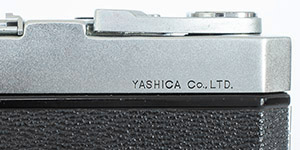
Many sources claim that production ended in 1960 and one source, Alan R. Corey, claims that a document given to him by Yashica/Kyocera marketing in 1993 shows that the Yashica 35 was made from April 1958 to March 1960 and that the other two rangefinder models without an exposure meter ended production at a similar time (YK in March 1960 and YL in January 1960). My serial number table above suggests that production of found Yashica 35 cameras stopped in December 1960 and that Corey, or Kyocera marketing, was also wrong about the Yashica YK.
Until nearing the end of production, all the cameras have trim consistent with their serial numbers, with perhaps the exception that f/1.9 “Yasinon” lenses continued to appear from time to time until the beginning of 1960. Then, some late examples in my database have one or more trim items that are from an earlier period, e.g. the last two cameras have the first type focus assist finger grip. Other features on the cameras are appropriately up to date. Another couple have the last type top plate engraving “YASHICA CO., LTD. MADE IN JAPAN” but have also reverted to the pre-1959 “MADE IN JAPAN” on the base plate. The most extreme example is the only f/2.8 “Yasinon” lens found in the wild. This is mounted on a camera with March 1960 serial number featuring the second type of focus lever in all black which first appeared earlier the same month (the second lever first appeared with black knob on silver support in August 1959, still much later than expected for a “Yasinon” lens). It seems likely that Yashica was using up excess inventory of unused/spare parts.
Trim Changes
Apart from the renaming of the lenses to “Yashinon” and the September 1958 maker name change, these were the trim changes from the start to end:
- Below is a photo of the top plates of f/1.9 May 1958 (bottom) and October 1959 (top) examples. These are the differences and when they occurred. The smooth rewind lever top and film wind lever without central nut with pin spanner holes on the bottom camera only appear in early brochures, on the first f/2.8 example and this very early f/1.9 example. This camera is also the last with an ASA only film speed reminder window. All subsequent examples have a combined scale as on the top camera. The “hole” behind the shutter button on the bottom camera disappeared in September 1958. The user manual calls this the “Red Dot” which indicates that the shutter is cocked and film wound ready for the next picture. This feature was instead incorporated into the film counter pointer on later cameras (see next dot point).
- The film counter graphics are different on the two examples above and changed at least one more time in between the two and once after. On the earlier bottom camera, the pointer is a simple white arrow, also shown in image one of three below. The second style, middle image below, was adopted in September 1958 but at least one f/2.8 example and two f/1.9 examples are transition cameras featuring the zebra pattern scale but the first type white pointer still. These transition cameras still have the separate Red Dot indicator but the full second style replaced the separate indicator with one incorporated into the film counter pointer. Behind the new black pointer is a hole which shows white when the shutter is not cocked (as also in the third type, uncocked top camera above), or red when it is (this one is probably showing white but in shadow, at first I thought it was black). The lead-in and zebra pattern of the scale are also very similar to the third type (top camera above and image below right) which arrived between July and September 1959, the main difference being the pointer which was originally black with the tip of the point sitting above the scale, whereas with the third type, the pointer is red and the tip sits flush with the edge. Also the plate on which the pointer sits is now wider, covering more of the window and zebra scale:
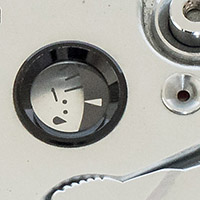
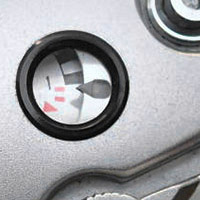
(Middle detail from larger web image)
- There is also a fourth type and possibly fifth both of which are quite rare. The first is the iffy one and appears on a March 1960 f/2.8 example and seems to be similar to the one below, only different but that maybe because the counter has reached 36 exposures. The other is on the last Yashica 35 in the database. Rather than a fixed pointer on an attached plate, the whole plate moves to indicate whether the shutter is uncocked (left image) or cocked (right image). The question that comes to my mind is, why?
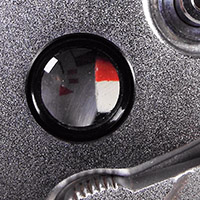
(Images courtesy of Chris Whelan)
- The viewfinder window originally had a black inside border which became silver in May 1958 already (the May 1959 f/2.8 example with Yasinon lens mentioned further above is the only later camera found with this feature - there are other examples of later cameras using up earlier trim parts). At the same time on the f/1.9 examples in my database, but as early as April already on f/2.8 examples, a screw was added to the cover plate, which includes the viewfinder frame, over the lens mount/board. This screw is visible in the right image below, to the left of the viewfinder, just below the last “a” of Yashica. On rangefinder cameras, this is usually a cover screw removal of which allows access to a smaller screw for horizontal rangefinder adjustment. Low resolution images of two cameras with the top plates removed, left without the screw, right with, suggest that a block has been added to the top of the lever attached to the spindle in the red circle and that the block has a small screw in its front face (left image is front on with internal lens shroud removed, right image is elevated view, the fronts of the accessory shoe supports are also slightly different but only the later one is visible):


(Left & right detail from larger web images)
- Near the same time in April/May 1958 but not exactly at the same time (the changes seemed to occur one at a time so almost no two cameras in my database are exactly the same at this point in production), there was a construction change with the front cover plate. On the first examples, there are no side retaining screws, left image without screws, right image with screws. Instead, there were two screws in the bottom edge - see top image of the pair immediately below:
- Also in May 1958, the push to release rewind button on the base plate changed to the turn to release type in the lower image. Twelve months later, between May 1959 and July 1959, the three screws around the tripod mount on the baseplate disappeared:
- Around July 1959, the engraved “MADE IN JAPAN” on the baseplate disappeared and was replaced by a label on the leatherette of the camera back with the words “YASHICA CO., MADE IN JAPAN”, in addition to the maker name still engraved on the back of the top plate (“Yashica Co., Ltd.” by this time), first image below (also visible in the larger photo of the two cameras further above). In October 1959, it was changed to “MADE IN JAPAN”, second image:
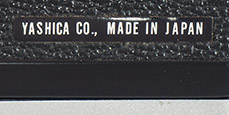
(Right detail from larger web image)
- In July or August 1959, the silver finger grip on the focusing ring was replaced by a grip which looks more like the traditional infinity lock (which it's not) similar/same as on the following YK model. In about December 1959, the second type focus lever changed to an all black finish:
- In January 1960, the label on the leatherette was dispensed with altogether and “Made in Japan” moved to the back of the top plate to join the maker name. The engraving is now “YASHICA CO., LTD. MADE IN JAPAN”. The first four examples are also like this but have a lower case “o” in “Co.,”:

(Image courtesy of Chris Whelan)
User Manual
Below is Chris Whelan's English language version of the user manual. The cameras pictured in the manual feature the very earliest trim (see above) from April 1958 but undoubtedly, the English version came after the camera was released. This printing at least features the “Yashica Co., Ltd.” name on the back cover, it changed from Yashima in September 1958.
The only body serial number visible is 841553 which is very early, April 1958, and fits the trim and “Yashima” maker name. Except the f/1.9 lens name shown on the first page is “Yashinon” with odd 5 digit serial number 00599 instead of “Yasinon” as might be expected. Yashinon f/1.9 numbers are 6 digit and the earliest I have found is 10257x (f/2.8 numbers are 5 digit, the earliest beginning with “3”). Part of the answer is that an early Japanese brochure confirms that camera serial number 841553 was in fact fitted with f/1.9 “Yasinon” lens, serial number 18275. This number is actually visible on another photo in the manual but the name is not. Therefore the photo with the “Yashinon” lens has been either doctored or given its unusual number, is a prototype lens/camera combination. An f/2.8 lens with serial number 43128 featured under “Self-Timer” is a genuine “Yashinon” belonging to a body that could fit anywhere between May and September 1958.
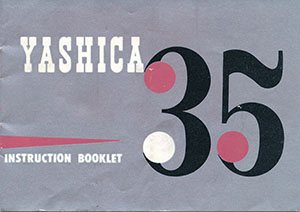 (Scan courtesy of Chris Whelan)
(Scan courtesy of Chris Whelan)
(Click on cover for PDF of full manual)
Following Models
It seems that the Yashica 35 remained in production whilst the next 2 models were released, in fact for most of their lives as well. These are the YK and YL. “K” before “L”, right? Not according to Japanese “Camera Collectors' News” of July 1987 which claims that the YK went on sale in August 1959 and the YL was released in April 1959. Alan R. Corey's 1993 Yashica/Kyocera marketing document more or less agrees but pushes the YL forward to May. The serial number tables below suggest that production commenced in March for the YL and June for the YK so the claims are pretty much confirmed. Nevertheless, I'll treat the two models alphabetically.
Yashica YK
The YK top plate is simply engraved “Yashica” with “YK” on the front window but the user manual calls it the “Yashica 35 YK”. It looks substantial and well made and very similar to the Yashica 35 except for a modified top plate with a slight step. However, it is most assuredly a budget model. The elegant long window on the front hides the fact that the rangefinder base has been shortened and the prisms replaced by mirrors, the film speed reminder is now a simple dial on the back and the automatic frame counter has been replaced by the simpler and very common manual reset type counter on top of the film wind lever:
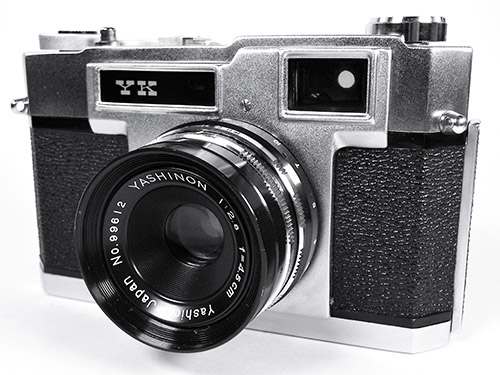
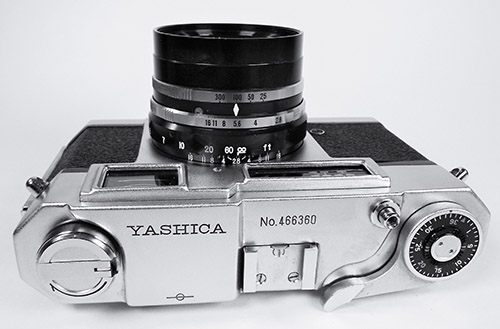 (Images courtesy of Chris Whelan)
(Images courtesy of Chris Whelan)
Compared to the Yashica 35, the YK seems to have the same lower part of the body and lens barrel design but the top plate is noticeably taller due to the higher placement of the viewfinder in the body. The reason for this is that on the 35, the rangefinder and viewfinder components are mounted separately to the upper body platform whereas on the YK, as also on the YL and following models, the rangefinder/viewfinder is a complete modular unit which is bolted on top of the platform. This no doubt simplified production.
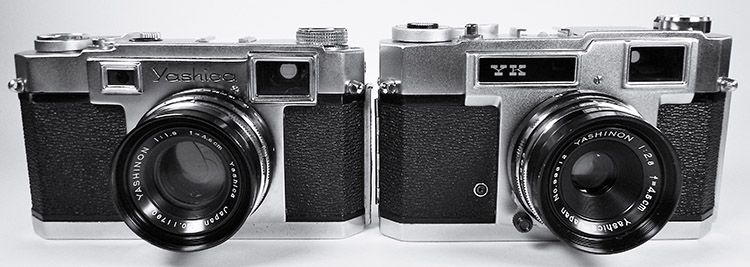
(Image courtesy of Chris Whelan)
The specs and price clearly put it below the f/2.8 versions of the Yashica YL and earlier Yashica 35 which continued to remain available for most of the YK's life:
 (Image and specs from circa 1959 US Brochure)
(Image and specs from circa 1959 US Brochure)
The Copal MXV shutter has been replaced by a simpler Copal type (“Copal” on the barrel, just visible, but the internal cover plate says “Copal SV”, this version of the SV is half empty under the cover).
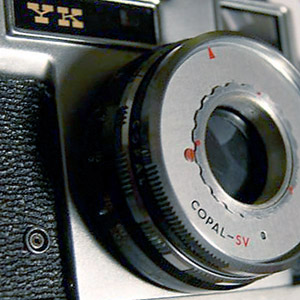 (detail from larger web image)
(detail from larger web image)
Consequently, the self-timer is gone and shutter speeds reduced to B and 1/25 to 1/300 (like the budget Yashica A TLR).
Only the one lens was available, an f/2.8 4.5 cm. The well known website, collection-appareils.fr, suggests that the lens is 4 elements in 3 groups, i.e. probably a Tessar, which is still a solid choice and wouldn't surprise me, and this Japanese website, asahi-net.or.jp, and Japanese Wikipedia claim the same.
The following are the serial number schema of found examples. This is based on a relatively small sample of only 30 cameras so there are likely to be more months of production, although with the Yashica 35 and Yashica YL in production at the same time, there would have been competition for production line space on one hand and danger of over-production on the other with 3 similar f/2.8 cameras vying for consumers' attention.
| Serial No. | Year Code |
Deciphered | Month Code |
Month | |
|---|---|---|---|---|---|
Showa |
Year |
||||
46xxxx |
4 |
34 |
1959 |
6 |
June |
47xxxx |
4 |
34 |
1959 |
7 |
July |
48xxxx |
4 |
34 |
1959 |
8 |
August |
410xxxx |
4 |
34 |
1959 |
10 |
October |
411xxxx |
4 |
34 |
1959 |
11 |
November |
412xxxx |
4 |
34 |
1959 |
12 |
December |
61xxxx |
6 |
1960 |
1 |
January | |
66xxxx |
6 |
1960 |
6 |
June | |
610xxxx |
6 |
1960 |
10 |
October | |
K 611xxxx |
6 |
1960 |
11 |
November | |
K 612xxxx |
6 |
1960 |
12 |
December | |
K 101xxxx |
1 |
1961 |
01 |
January | |
K 102xxxx |
1 |
1961 |
02 |
February | |
Note: The numbering system starting with January 1961 is the same as with TLRs which remained in place until 1980.
There were several minor trim changes. Except for the first one, these were similar to the later Yashica 35 updates and occurred at a similar time:
- Initially, the accessory shoe was secured by three visible screws (see photo at top of section) but by July 1959 already, there was a cover plate hiding the securing method (this is different to the Yashica 35 type which was there from beginning to end):
(Image courtesy of Chris Whelan)
- The YK started off with a label on the camera back leatherette with the words “YASHICA CO., MADE IN JAPAN”. Between August and October 1959, this was simplified to “MADE IN JAPAN”. Although the labels were the same as found on the mid/later Yashica 35 examples, in neither case was the maker name engraved on the top plate as on the Yashica 35. This changed in January 1960 when the label was replaced by first “YASHICA Co., LTD. MADE IN JAPAN” and then later in the same month “YASHICA CO., LTD. MADE IN JAPAN” (the “Co.” became “CO.”) engraved into the back of the top plate making both models the same. Two random cameras in the middle are without labels and top plate engravings but have “MADE IN JAPAN” on the base plate like the earlier Yashica 35 examples - Yashica using up parts?
- Between January and June 1960, the focusing assist lever changed to all black (same style). The same change occurred on the Yashica 35 in March 1960.
Yashica YL
Yashica hadn't abandoned more advanced specs and features with the release of the YK. Enter the unusual, and to my eyes at least, visually challenging, YL model. This has a completely new body and look which seems to echo elements of both the Nicca III-L and Yashica YF. This time, the top plate is engraved “Yashica 35” with “YL” on the front and as with the YK, the user manual calls it the “Yashica 35 YL”:
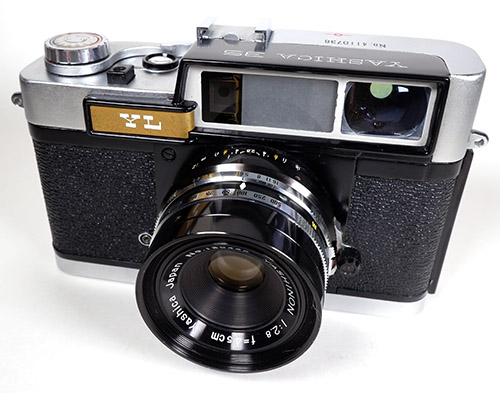 (Image courtesy of Chris Whelan)
(Image courtesy of Chris Whelan)
It's the YF like stepped top plate with III-L like black viewfinder/rangefinder window insert that makes it stand out but there are other more interesting features. The bright line viewfinder is now usefully parallax correcting. The automatic frame counter makes a return and the film speed reminder moves to the top of the film wind lever. The top plate and viewfinder placement don't easily allow for a rewind knob/crank so Yashica added a pull-out crank to the bottom plate. This apparently works well but does add cost and complexity with an internal shaft and gears required:
 (Detail from larger web image)
(Detail from larger web image)
The extract from the US brochure below identifies two versions; the “Yashica YL2” and “Yashica YL1”, the former with f/2.8 lens and the latter with f/1.9 lens and Light Value (LV) scale marked on the front ring and a “coupling ring” (as described in the user manual) to enable moving the shutter and aperture together for any given LV. Although not strictly necessary, the LV scale is most useful when using an exposure meter that provides a reading in LV numbers.
 (Images and specs from circa 1959 US Brochure)
(Images and specs from circa 1959 US Brochure)
Most wikis will tell you something similar to what is in the brochure and what I originally wrote:
There are two versions, one with f/1.9 lens 4.5 cm Yashinon lens mounted in a Copal SVL shutter and the other with an f/2.8 Yashinon lens mounted in a Copal MXV shutter. Both versions are fitted with a self-timer. Japanese Wikipedia claims that the f/1.9 version was released first and featured the same construction lens as on its Yashica 35 predecessor (6 elements in 4 groups) and that the f/2.8 wasn't released until 1960, also featuring the first f/2.8 lens construction of 5 elements in 4 groups.
It's actually a lot more complex - there are many lenses (well, 3 apertures at least and 4 in total), and Japanese Wikipedia is wrong, at least from the global perspective, the f/2.8 version appeared right at the beginning. Of course, Japanese Wikipedia may have only been considering the Japanese market where the release may have been different (the only found in Japan f/2.8 camera in the table below was built in November 1959). The following table lists actual cameras found by serial number and their lens types, two trim variations and country they were found in, if identifiable. Some of the other gaps are due to the information being added afterwards and the cameras could not be found again, and some are due to features not being visible, particularly the rangefinder window masks. I know that there were at least one or two cameras from the US but I can't identify them now:
| Serial No. | Year/ Month |
Shutter Button |
Rangefinder Window |
Lens | Lens No. | Country |
|---|---|---|---|---|---|---|
4930039 |
1959/5 |
Black square |
Diamond |
f/2.8 | (Manual) | |
430209 |
1959/3 |
Black square |
Diamond |
f/1.8 type A | 394179 |
(Manual) |
43057x |
1953/3 |
Black square
|
f/1.8 type A | 39385x |
Japan | |
44039x |
1959/4 |
Black square |
f/1.8 type A | 39462x |
Japan | |
45079x |
1959/5 |
Black square |
f/1.8 type A | 394486x |
UK | |
45224x |
1959/5 |
Black square |
f/2.8 | 8634x |
||
45229x |
1959/5 |
f/1.8 type A | 394611x |
|||
46192x |
1959/6 |
Black square |
f/1.9 | 125xxx |
Poland | |
47020x |
1959/7 |
Black square |
f/1.9 | 12364x |
Slovenia | |
47074x |
1959/7 |
Black square |
f/1.8 type A | 394857x |
Japan | |
47112x |
1959/7 |
Black square |
Diamond |
f/1.8 type A | 394906x |
Japan |
47141x |
1959/7 |
Black square |
Diamond |
f/1.8 type A | 394857x |
|
47151x |
1959/7 |
f/1.9 | 12561x |
|||
47154x |
1959/7 |
Black square |
Diamond |
f/1.8 type A | 396035x |
|
47612x |
1959/7 |
Black square |
Diamond |
f/2.8 | 7833x |
Australia |
48196x |
1959/8 |
Black square |
f/1.8 type A | 394610x |
||
48247x |
1959/8 |
Black square |
Diamond |
f/2.8 | 7844x |
Australia |
48480x |
1959/8 |
Black square |
Circular |
f/2.8 | 13972x |
Sweden |
49329x |
1959/9 |
Black square |
f/1.8 type A | 39576x |
Japan | |
59032x |
1959/9 |
Black square |
Diamond |
f/1.8 type A | 396605x |
Japan |
59032x |
1959/9 |
f/2.8 | 9427x |
|||
59052x |
1959/9 |
Black square |
f/2.8 | 10088x |
UK | |
59066x |
1959/9 |
Black square |
f/1.9 | 12543x |
UK | |
4101xxx |
1959/10 |
Black square |
Diamond |
f/1.9 | 12653x |
Australia |
410135x |
1959/10 |
Black square |
Circular |
f/1.9 | 12917x |
|
410189x |
1959/10 |
Black square |
Diamond |
f/2.8 | 11329x |
|
410329x |
1959/10 |
f/2.8 | 10972x |
|||
410421x |
1959/10 |
Black square |
f/1.8 type A | 394446x |
Japan | |
410571x |
1959/10 |
Black square |
f/2.8 | 13178x |
Australia | |
410601x |
1959/10 |
Black square |
f/1.9 | |||
410632x |
1959/10 |
Black square |
Circular |
f/1.9 | 12939x |
Singapore |
411030x |
1959/11 |
Black square |
Circular |
f/1.9 | 12953x |
UK |
411073x |
1959/11 |
Black square |
Circular |
f/2.8 | 13043x |
UK |
411124x |
1959/11 |
Black square |
Circular |
f/1.9 | 12779x |
Japan |
411157x |
1959/11 |
Black square |
Circular |
f/1.9 | 12766x |
Japan |
411172x |
1959/11 |
Black square |
Circular |
f/1.8 type A | 396045x |
Japan |
411197x |
1959/11 |
Black square |
Circular |
f/2.8 | 13765x |
Japan |
411xxxx |
1959/11 |
Black square |
f/1.9 | 128104 |
Japan | |
412111x |
1959/12 |
Chrome round |
Circular |
f/1.8 type A | 394332x |
Japan |
412166x |
1959/12 |
Chrome round |
Diamond |
f/1.8 type A | 39704x |
Japan |
412194x |
1959/12 |
Chrome round |
Circular |
f/1.8 | 595096x |
|
412325x |
1959/12 |
Chrome round |
f/1.8 | 595061x |
Japan | |
61011x |
1960/1 |
Chrome round |
f/1.8 type A | 396309x |
||
61033x |
1960/1 |
Chrome round |
Circular |
f/1.8 | 595115x |
Japan |
61071x |
1960/1 |
Chrome round |
f/1.8 type A | 396309x |
Japan | |
61080x |
1960/1 |
Chrome round |
Diamond |
f/1.8 type A | 396067x |
|
61093x |
1960/1 |
Chrome round |
Circular |
f/1.8 | 595001x |
Note, to understand how the year codes work, refer to the Yashica 35 serial number table further above.
The table tells us a number of things. First about the serial numbers. Production starting in March 1959 and ending in January 1960 seems to be in line with a release date of April or May, depending on source, and the January end date claimed by Alan R. Corey. As with the Yashica 35, there are several cameras with serial numbers beginning with “5”. This seems to equate to 1959 but I can't explain how that works in terms of either Showa or the western calendar. It may be that Yashica has really tricked us by omitting the “9” of “59” for 1959. Although I have identified two trim changes in the table (there are also three versions of the focus assist lever, see further below for all trim variations), the way that there is a hard cut over from one type of shutter button to the other is consistent with my understanding of the serial numbers.
(Note: The second camera in the table is the camera in the English user manual for the f/1.9 version camera. The lens in the table is one of two different lenses identified in the manual so it may, or may not, match the camera in the table. The lens serial number and style of text is clear on the “Taking Flash Pictures Page”. The aperture of neither lens is visible but the other has a different text style and a serial number that might be 10000x. For the purposes of the table, I have assumed that the lens with most details visible is an f/1.8 type A, (my terminology) based on its serial number and style of text.)
It could well be that the f/2.8 and f/1.9 lenses are from the Yashica 35 but the existence of not just one but two versions of the f/1.8 lens is massively intriguing. The only thing that I can say about these lenses is that the pair look like a match for the two different Lynx 1000 versions considered and physically examined in Claims of Zunow Sourced 35 mm Lenses. The type A text on the front looks like what Chris Whelan and I allege might be the earlier Zunow version. The underlined “o” in “No” and the “a”s and the font generally for “Japan” look much more typically Zunow than Yashica and again, the serial numbers are 6 or 7 digit and start with first digit “3”. Examples of the four YK lenses below:

 (Detail from larger web images)
(Detail from larger web images)
The advertised f/2.8 (left) lens and f/1.9 (right) lens.
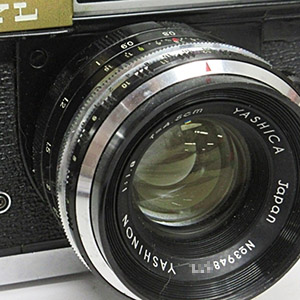
 (Detail from larger web images)
(Detail from larger web images)
The unexpected and unusual f/1.8 type A (left) lens and unexpected but more typical f/1.8 (right) lens.
Some observations. The two f/1.8 and f/1.9 lenses all have a similar barrel with LV ring at the front. The f/2.8 lens has a similar barrel to the Yashica 35 and Yashica YK lenses. The letters on the f/2.8 lens look perhaps a little finer than the other three lenses but it is a similar font to the f/1.9 and f/1.8 lenses and looks very similar to the Yashica 35 and YK lenses. With the f/1.8 type A lens, note the unique underlined “o” in “No” and the different “a”s and the “J” in “Japan” and also, it is the only example with “YASHICA” all in capitals (the Lynx version of the lens doesn't capitalise the Yashica name). The image below makes the differences clearer but note, the lens has a filter fitted:
 (Detail from larger web image)
(Detail from larger web image)
The f/1.8 type A seems to be the large lens version fitted at the beginning but it is still there at the end as well. The second f/1.8 lens first appeared in December 1959. Both f/1.8 lenses appear to only have been offered in the domestic Japanese market - note, the one f/1.8 type A found in the UK was bought at a car boot sale by correspondent Michael James in circa 2011 and could have found its way to the UK earlier. The f/1.9 lens was the large aperture lens offered in export markets but also appears to have been available in Japan, unless the three examples were imported by collectors and/or have escaped from US Service personnel. In case anyone is wondering why the f/1.8 versions weren't advertised, here are the relevant parts of two Japanese brochures, the first featuring a number of models (full page is here):
.jpg) (Scan courtesy of Chris Whelan)
(Scan courtesy of Chris Whelan)
(Click on brochure page for larger view)
.jpg) (Scan courtesy of Chris Whelan)
(Scan courtesy of Chris Whelan)
(Click on brochure page for larger view)
Without translation, it is clear the the lenses are f/1.8 in both documents. The reference to “Yashica 35 L” in the first scan would have only been understood by Yashica's marketing department but the cameras that we know as, and are marked as, YE, YK and YL are sometimes, in fact mostly, advertised in Japan without the “Y”. More here.
In November or December 1959, the shutter button changed from the odd square black type back to a more conventional type (f/2.8 lens barrel on left camera compared to one of the large aperture types on the right):

 (Detail from larger web images)
(Detail from larger web images)
There are also some variations with the focus assist lever. Generally, it is the second Yashica 35 type (same as found on earlier Yashica YK examples) but the first two with f/2.8 lenses use the first type silver Yashica 35 finger grip (bottom right of first image below). I'm guessing that whilst these two are not the earliest cameras, it has something with to do with the f/2.8 YL sharing lens barrels with the Yashica 35 and YK. Then there are two earlyish cameras with f/1.8 type A lenses that have a silver ring at the front of the black cylindrical grip instead of being all black - the same style also appears in the US and Japanese brochure images. The rings seem to have a bigger diameter than the standard black variety and the alloy mount does not have chamfered/scalloped ends near the mounting screws like the common type, see third image and also Yashica 35 trim examples (note that the second example below seems to have the rangefinder window assembled back to front):


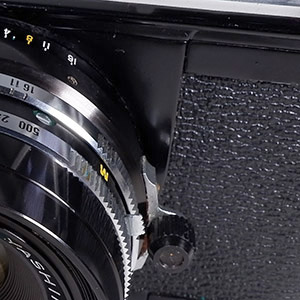
(First 2 images, detail from larger web images, third image courtesy of Chris Whelan)
Another variation first noticed by Chris Whelan is that while most of the YL examples, including those in the f/2.8 and f/1.9 user manuals, have a diamond shaped mask in the rangefinder window, later cameras often (but not always) have a circular mask.
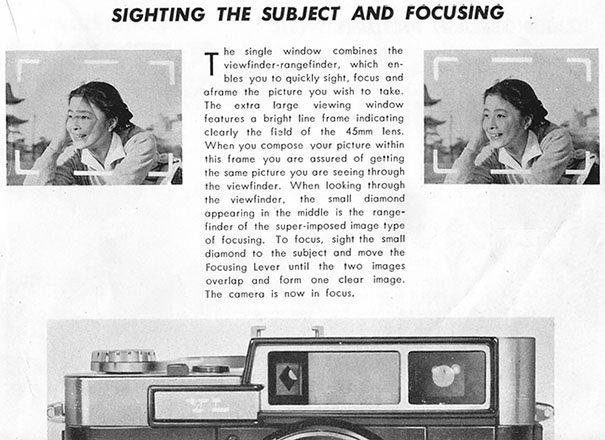
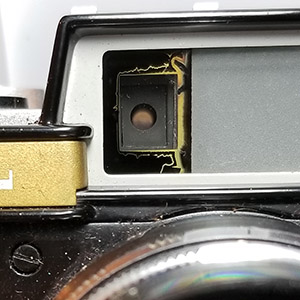
(User manual scan & image courtesy of Chris Whelan)
Brochures
I have put these Japanese brochures here because they include the models covered so far and they introduce The Next Generation below. They are both from 1960, the left a little earlier than the right:
(Click on covers for full PDF)
Both brochures feature the “Yashica 35 Minister” and the second adds the “Yashica 35 Lynx”. Even at this late stage, the YK and YL in both are headlined as “Yashica 35 K type and Yashica 35 L type” in the first brochure and “K type and L type” in the second.
The first brochure calls the Yashica 35 “Yashica 35 F 2.8 S”, the second more circumspectly “35 F 2.8 S” with the “F 2.8” much smaller. For those that believe in a “Yashica 35 F” model, this is no help as “F 2.8” was Yashica's way of writing the aperture for any of the contemporary models. The mystery for me is that the f/1.9 lens version seemed to disappear from Japanese advertising in 1959 even though there a couple in my database from the last month of production, although admittedly, virtually nothing in the months earlier. Then there is the “S” which seemed to appear when the f/1.9 ads stopped. What does that mean?
The Next Generation
Note: My main reference for most of the model information and dates is the Japanese specialist magazine, “Camera Collectors' News” of July 1987. It doesn't mention the Yashica J and its 35W twin. Sugiyama covers the Yashica J and the for 35W, I have relied on brief mentions elsewhere and photos to confirm its existence and details. The magazine also claims that the Flash-O-Set was released in June 1962. That is likely to be the year for the pictured Flash-O-Set II, confirmed by Sugiyama, other evidence, including serial numbers, suggests that the original model was released in 1961.
After the Yashica YK and YL came a slew of similar rangefinder models initially based on the YL body but with new flat top plate. The base plate rewind crank was still there for the first new model released in 1960, the “Minister” (see also brochures above), but disappeared with the Minister II restyle which followed the modernised Lynx 1000 design cues.
During this period, Yashica also released a number of half-frame models, starting with the unconventional Rapide in 1961, but that is a whole other story.
Mainstream Mid-range Minister Models
The mid-spec Yashica Minister with an f/2.8 4.5 cm Yashinon lens was released in February 1960 and features a selenium cell exposure meter for the first time:
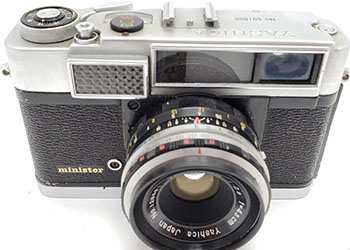
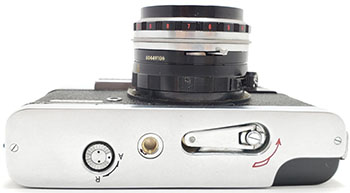
(Detail from larger web images)
In a similar pattern to the YL serial numbers detailed earlier, the serial numbers of 1960 cameras (first digit “6”) feature 6 or 7 digit serial numbers depending on month. Somewhere in the October to December period, the prefix letter “M” was introduced. Beginning with January 1961, the pattern was M 101xxxx where “1” represented 1961 and “01” represented January. This is basically the same as for TLRs to 1980 and for the other rangefinder models until the late 1960s.
There is a claim that the model was released as the “Yashica M” and the name was changed to “Minister” after Leica complained. That is fake news. The “Yashica M” (called the “35M” inside the English user manual, “Yashica 35 Model M” on the cover and on the presentation box and “Yashica M” on the front of the camera) was released 4 months later in June 1960 as a version of the Minister with f/1.9 4.5 cm Yashinon lens:
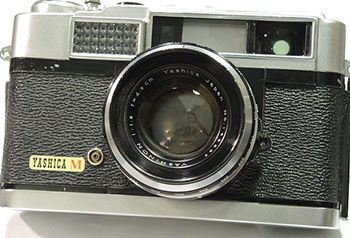 (Detail from larger web image)
(Detail from larger web image)
Its replacement, the Minister II was released in May 1962. Its body is easy to tell apart, it now looks like the Lynx 1000 model and features a traditional top mounted rewind crank, however, confusingly, the name on the front remains “Minister” (now under the viewfinder), however, the serial numbers are prefixed with “II” replacing the earlier “M”. Surprisingly, there was also an “M-II” with the model engraved on the front of top plate, otherwise it looks like a Minister II. Both the Minister II and the M-II user manuals use Minister II photos inside with the camera name shown as “Minister” (both manuals downloadable from Mike Butkus). To complicate matters even further, there was both a “black face” and “white face” Minister II:
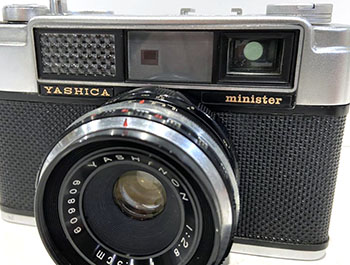
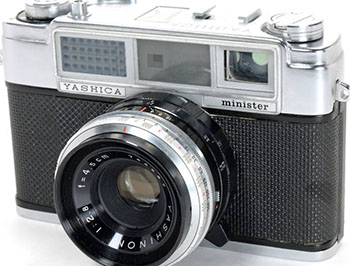
(Detail from larger web images)
The M-II version
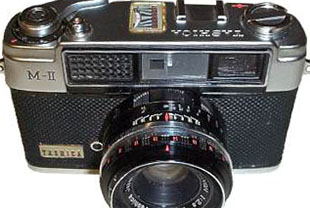 (Detail from larger web image)
(Detail from larger web image)
The lens is an f/2.8 4.5 cm but Camera Collectors' News tells us that an export version with f/1.9 lens was launched in November 1964.
Next model released was the Minister D in December 1963 featuring a CdS exposure meter. The lens was the f/2.8 4.5cm Yashinon:
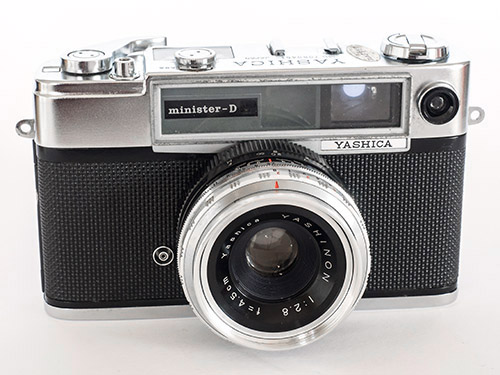
The earliest serial numbers are in a date code format and range from MD 312xxxx to MD 709xxxx followed by 6 digit consecutive numbers with a “T” prefix from T 05035x to T 80868x. Both ranges are engraved “Japan”. Then there are a couple of cameras with typical 6 digit Hong Kong numbers, H 11021x and H 13629x with no country indicated.
Unusually, but not without precedent, two months of the date coded numbers feature 8 digits instead of 7. With TLRs until 1980 and fixed lens rangefinder models until the late 1960s, in a couple of cases into the early 1970s, the date coded numbers usually feature a 4 digit sequence number at the end which counts monthly production. With TLRs, it is always 4, meaning production didn't exceed 9,999 cameras for the month. In 1959, with the Y16, which used the same format numbers as the TLRs for that period, several times the sequence number went to 5 digits meaning production for those months was planned to reach and exceed 10,000. The only other models apart from the Minister D that I have noticed this for are the Minimatic-S and C. Note, production of a model wouldn't have cranked along at these outputs consistently, production lines would have been producing several/many models and some months there may have been relatively very few, if any, of one model made.
According to the Camera Collectors' News article, a version with an f/1.8 lens, presumably from the Lynx 1000, was launched in August 1964:
 (Camera Collectors' News of July 1987)
(Camera Collectors' News of July 1987)
The Minister 700 arrived in October 1964. It is the same as the Minister D except for the new f/1.7 4.5 cm Yashinon lens. The only serial numbers I have seen are 7 digit with an “MC” prefix:
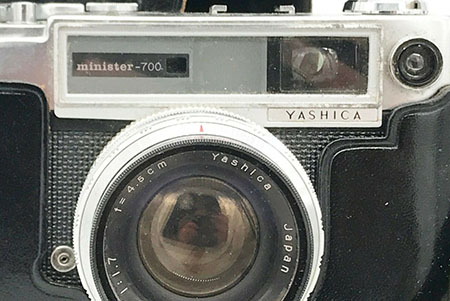 (Detail from larger web image)
(Detail from larger web image)
Contrary to popular folklore and even claims in Camera-wiki.org and the Yashica Guy's website, the Minister III didn't arrive in 1963 and fit between the Minister II and Minister D, it first appeared in 1966. I think that in the absence of access to other evidence, somebody early on has made an “educated” guess and got it wrong. The Camera Collectors' News of July 1987 article tells us it was released in March 1966, one month after the Electro 35. The fact that it has a selenium exposure meter still may seem strange but it was the market and price points that Yashica was aiming at. The Minister III and D, along with a couple of Lynx models and the J (in a travel kit) still appear in a 1969 Yashica USA price list. Here it is in a brochure with the Electro 35 and Lynx 5000E and Lynx14E released in 1968:
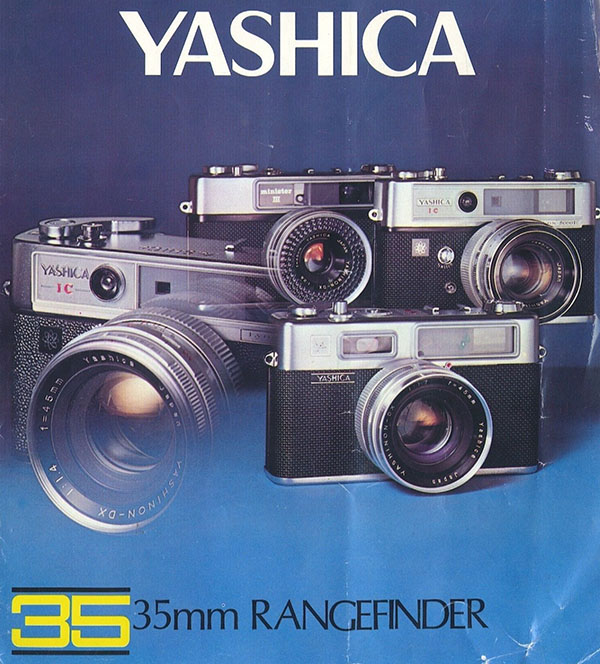
(Detail from larger web brochure)
But why the Minister III name after the Minister D? Because it wasn't intended to be called that, its release name was the “Yashica M-3”. As well as some murmurings around the Internet, the Japanese magazine confirms that Leica was understandably upset and threatened, or took, legal action resulting in the name change to Minister III.
When claims are made, they need to be tested and one of my first tools is to create a database. From that, I can confirm several things. The serial numbers fall into two ranges, the first half are almost certainly date coded in typical Yashica practice at the time as described above (see also Serial Numbers page), however, this time there is no model prefix. The earliest cameras are from January and February 1966, fitting with a March release. The second half have a “H” prefix typical of Yashica's Hong Kong production (some of these cameras have “Japan” in the accessory shoe whilst others have “Hong Kong” engraved on the back with one featuring the unusual “Processed in Hong Kong”). Hong Kong production is typically associated with the 1968 opening of Yashica Hong Kong Ltd. Also, one camera has been found with a 6 digit serial number with “N” prefix, N 80309x and “Japan” engraving on the back like earlier cameras. The number seems to be part of the same series as the “H”, numbers, the first in my database being H 80808x.
About the earliest one third of cameras I have found have “M-3” engraved on the front next to where “Minister III” is found on later cameras with “Yashica” there on the M-3 instead:

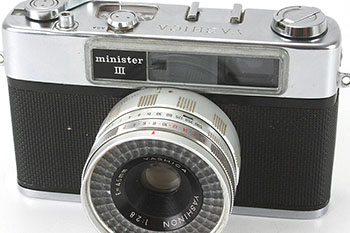
(Detail from larger web images)
Approximately the first half of cameras in my database, including all the M-3s, have lenses marked “Yashinon-DX” and the second half have lenses marked “Yashinon”. Both are f/2.8 and are now marked 45 mm instead of 4.5 cm in keeping with their more recent origins.
Note that the silver lens barrel and clean top plate design have more in common with the Electro 35 style than the earlier Minister II, D and similar vintage models, including the Lynx 1000 below.
Top Spec Lynx Models
Above the Minister models sat the Lynx models which took the specs a step or two higher. The Lynx 1000, released in June 1960, was the first. With similar body and features to the still to be released Minister II, it added a 1/1,000 shutter, hence the “Lynx 1000” name. Most examples are found with an f/1.8 4.5 cm Yashinon lens:
 (Image courtesy of Chris Whelan)
(Image courtesy of Chris Whelan)
A small number were supplied with an f/2.8 4.5 cm lens. I have found four examples, one from 1961 and three from 1962. The f/1.8 versions have the “Yashica” label on the left and the “Lynx 1000” label on the right whereas the f/2.8 versions are reputed to be the other way around. The earliest three examples are like that but the last one is not – whether there was a change, or there has been some fiddling, is not known. Also, the two middle examples with serial numbers very close, S 204341x and S 204437x, use the serial number prefix “S” instead of the “L” used by all other Lynx 1000 examples of both lens types, except for earlier 1960 numbers without prefix:
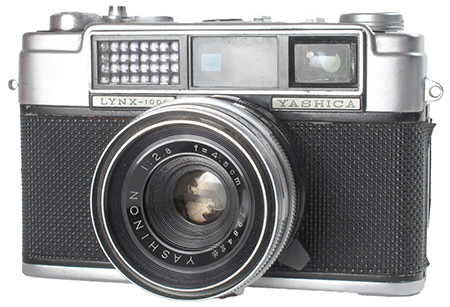 (Web image)
(Web image)
The f/1.8 lens appears to be shared with the outgoing Yashica YL and as noted for that camera, there are two versions, one of which has been controversially suggested to be sourced from lens maker Zunow, presumably the same as found on the Neoca SV Deluxe camera. More here. About 50% of the 1960 lenses appear to be of the “Zunow Tpe” but there are none in 1961 or later.
In a similar pattern to the Yashica YL and Minister serial numbers detailed earlier, the serial numbers of 1960 cameras (first digit “6”) feature 6 or 7 digit serial numbers depending on month. Beginning sometime in early November, the prefix letter “L” was introduced so the number would look like L 611xxxx which could easily be confused as being a 1966 number (there are no 1966 Lynx 1000 cameras). Beginning with January 1961, the pattern was the more conventional L 101xxxx where “1” represented 1961 and “01” represented January. There are 51 examples inclusive in my database between then and serial number L 401xxxx (1964, January).
The 1000 was followed by the Lynx 5000 (May 1964) with CdS meter and the famous, expensive and heavy Lynx 14 (April 1965) with f/1.4 lens (shutter reduced to 1/500 to cope with the larger diameter to travel).
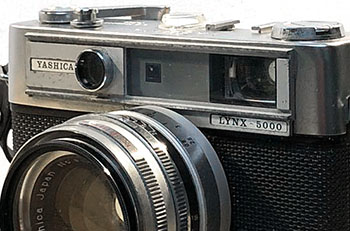
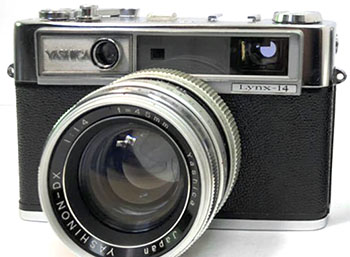
(Detail from larger web images)
The prefix for the Lynx 5000 serial numbers is “LII”. The ones I have found are all 7 digit and range from LII 403xxxx to LII 812xxxx. All are engraved “Japan”. The Lynx 14 uses the prefix “LIII”. Found numbers range from LIII 503xxxx to LIII 802xxxx, again all engraved “Japan”.
These two models were later updated to the 14E and 5000E and released in February and May 1968 respectively. In both, the main change was that the galvanometer meter displays on the top plate and viewfinder were replaced by electronically controlled under/over lights in the viewfinder:

(Detail from larger web brochure)
Both featured “IC” below the Yashica name and most examples also feature the Electro electron symbol but it is not there in the first few months of production of either, cover of 5000E user manual shown:
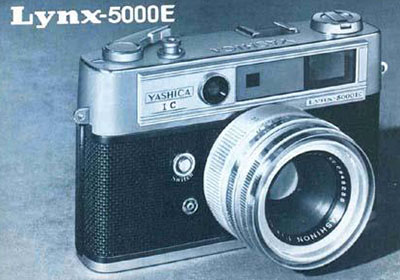
Neither cameras' serial numbers feature a prefix. The Lynx 14E serial numbers are 7 digit and still look like they are all date coded (2nd digit never higher than “1”). In my small database, they start with 802xxxx (1968, February, I'd expect to find up to a couple of months earlier) and rise to 905xxxx (1969, May). The next number is 002xxxx which is 1970, February and rise to 201xxxx (1972, January).
The Lynx 5000E serial numbers are the same format and also start from 802xxxx (1968, February, probably about right for a May release) with the series ending at 206xxxx (1972, June). Up to this point, all examples are engraved “Japan”. Then there is 6 digit serial number H 90185x followed by 92552x without prefix. Both are engraved “Hong Kong”.
Budget Range
There are three budget models without exposure meters plus three little known variants of one. The bodies look similar to the Minister II but as that wasn't released yet, the inspiration and basis would have been the Lynx 1000. The Yashica J is claimed to be from 1961. The lens is still a Yashinon f/2.8 4.5 cm but the shutter has a reduced set of speeds from 1/25 to 1/300. The Yashica 35W has similar specs to the J, except for the absence of a self-timer, but seems cheaper built, e.g. it has a different covering to other models, the top plate is similar but plainer with less detailing and there are no strap lugs. Serial numbers suggest that it was released in 1962. Image 1 is the first version of the J, it is the same as in the user manual and features the earliest serial numbers. Image 2 with “Yashica” under the viewfinder is the second and more common “blackface” version and image 3 is the later “whiteface” version. Image 4 is the Yashica 35W:
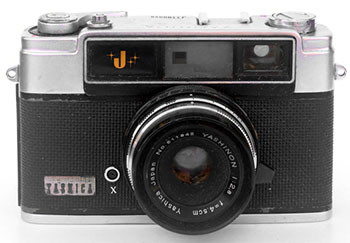
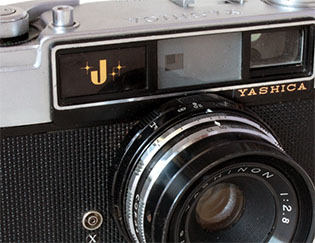
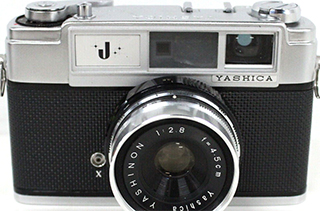
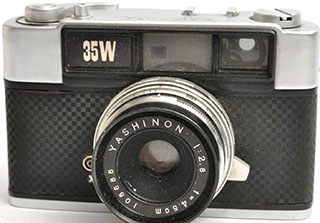
(Detail from larger web images)
The first series of Yashica J serial numbers in my database range from J 106xxxx to J 409090x. As the Yashica J was still offered as part of a “travel kit” in the 1969 Yashica USA price list, along with the Yashica D and Minister III, and in the May 1972 Yashica Dealer Notebook, I would expect the date coded numbers to extend to at least 1967 or 1968. These are followed by 6 digit numbers with an “N” prefix, N 71088x and N 72539x. Up to this point the cameras are engraved “Japan”. The next number is 6 digit without prefix 00694x but is presumably an early Hong Kong camera with “Hong Kong” being engraved on the top plate. Subsequent cameras H 02395x and H12745x have the “H” prefix typical of Hong Kong cameras but without the country being engraved.
The found Yashica 35W serial numbers run from W 209042x to W 2113211x suggesting late 1962 production only. However, the 35W seems to be a later rename of the Yashica Wizard which was one of three identical cameras, except for names, the other two being the Wizard W35 and Valiant. All are fitted with “Wizner” lenses which appear to be identical to the Yashinon of the later Yashica 35W. I am guessing that the “Wiz” in Wizner comes from Wizard. The found Yashica Wizard and Wizard W35 serial numbers run from W 104076x to W 105135x, the one Valiant number is 109003x (no prefix). Given their rarity, production was probably limited to 1961. A clue to their reason for being is to be found with Yashica movie cameras.
The “Yashica AIII” 8 mm movie camera is a little known clockwork model based on the battery powered Yashica 8M released in 1960. It's definitely a budget model even though it has a triple turret. There are also identical “Wizard 8” and “Valiant 8” cameras. All three are fitted with “Wizner” lenses which have silver aluminium barrels quite different to any other Yashica movie camera lens, probably bought in specially and renamed. Their serial numbers also suggest 1961 production. One Wizard 8 has been found with its box and guarantee papers (not filled in) with the company name, “Brother International Corporation Camera Division”. “Wizard” was also a name used by Brother for its sewing machines so that connection makes sense.
My guess is that the Wizards were cut price versions specially created for Brother from existing models (Yashica J and Yashica 8M) and that Yashica decided to sell its own versions, the Yashica Wizard (later called the 35W) 35 mm and the Yashica AIII 8 mm cameras. Valiant was presumably a different commercial client, so far unidentified. Yashica Wizard:
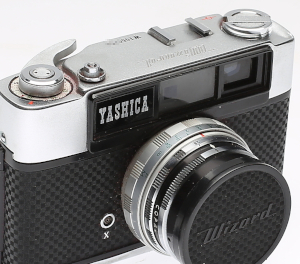
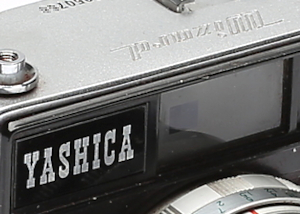
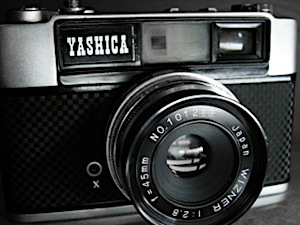 (Web images)
(Web images)
Wizard W35 on left and Valiant on right:
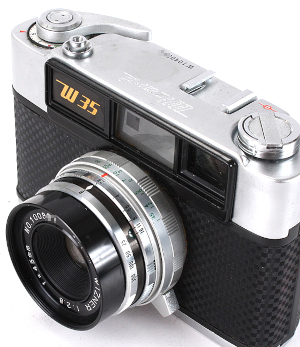

(Web images)
The Campus, released in April 1962, is very similar to the Minister II released a month later but is without the meter. In terms of specs, it has a shutter with the full range of speeds to 1/500:
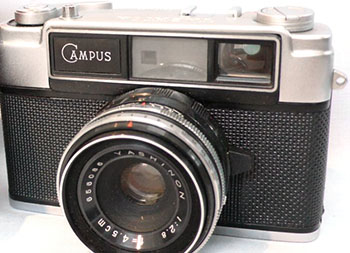 (Detail from larger web image)
(Detail from larger web image)
Campus serial numbers also started off with 7 digits, this time using an “S” prefix. I also have seen a non-date coded 6 digit number still with the same “S” prefix (i.e. unlike the Yashica J and Minister D where the prefix changed).
Automation
Perhaps forerunners to the more sophisticated Yashica EE, or simply aimed at a different market segment, the quite different Flash-O-Set (1961) and its successor, Flash-O-Set II (1962), were the only non-rangefinder types of their generation and featured similar but unique bodies with a flattened front panel. Both are fitted with fixed focus 3 element f/4 Yashinon lenses and feature the single speed shutter, built-in bulb flash and very basic selenium cell based exposure automation used later on the Yashica E TLR, more here. The biggest change from the first model to Flash-O-Set II is the move of the selenium cell from next to the viewfinder to around the lens but the II also revised the top plate to feature more of the design cues from the rangefinder models including a decorative panel between the viewfinder and flash:
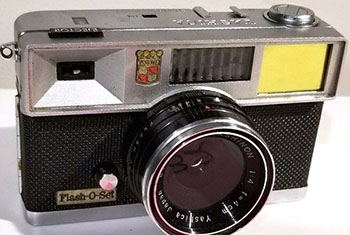
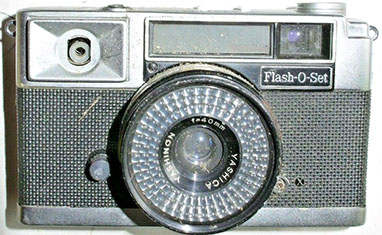
(Detail from larger web images)
Both cameras feature typical 7 digit serial numbers with date codes with the Flash-O-Set using a “T” prefix and Flash-O-Set II an “FII” prefix. The “T” numbers I have found begin with “1” and go as high as 112xxxx (1961, December) before “2” numbers begin. “FII” numbers begin with “2”, so far I haven't seen any with “3”.
Released in October 1962, the Yashica EE offered more sophisticated selenium cell based auto aperture automation with manual speed selection, i.e. shutter priority, in a rangefinder body resembling the Lynx and Minister models, “blackface” on left and “whiteface” on right, both with f/1.9 lenses, an f/2.8 version was also available:
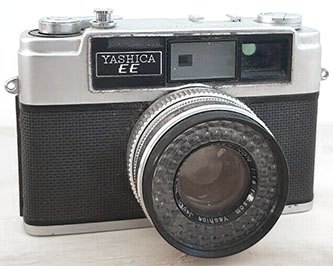
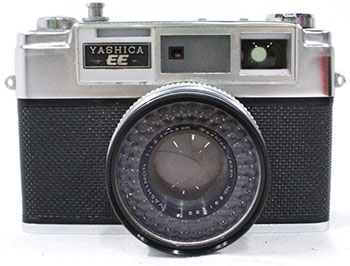
(Detail from larger web images)
There is a full range of shutter speeds to 1/500 and manual setting of aperture is possible.
Serial numbers are 7 digit with an “LE” prefix and typically begin with “2” or “3” indicating 1962 and 1963 production.
This was followed by the Minimatic-S with f/1.9 lens in February 1963, the Minimatic-C version with f/2.8 lens was also released in 1963 but I'm not sure when, possibly at or near the same time. Still selenium cell powered, this offered fully automatic exposure with the camera selecting both aperture and shutter speed. As the user manual confirms that the lowest available speed is 1/30 before resorting to the manual bulb setting, I suspect that the shutter may have a limited range of speeds, topping out at perhaps 1/300. As well as the manual bulb setting, it is possible to set the aperture manually but then the shutter speed is restricted to 1/30. The main purpose of this feature is flash photography. What could be mistaken as an exposure meter on the top plate is a DIN/ASA film speed selector. Whilst it appears over-engineered, it probably makes exposure compensation easier. Top half of Japanese Minimatic-S brochure:
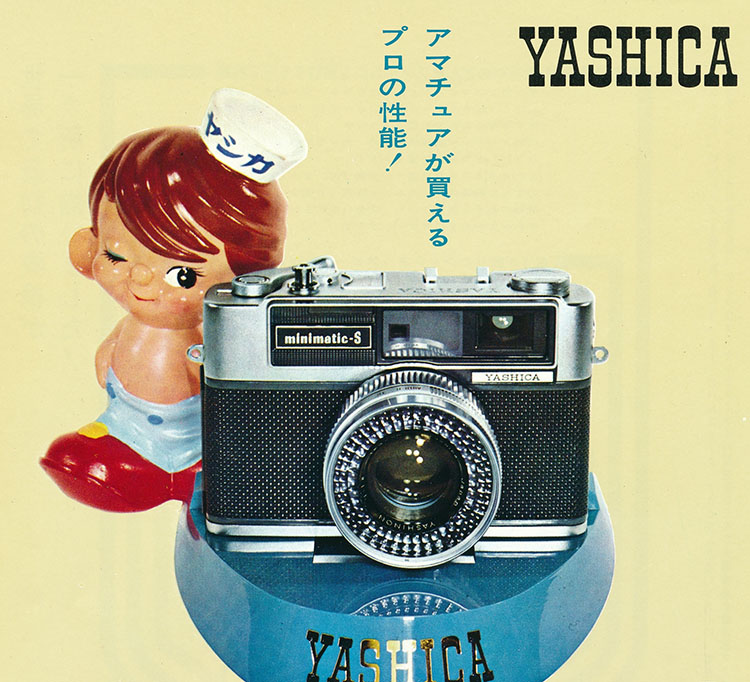
(Brochure scan courtesy of Chris Whelan)
As with some other models, both cameras were first released in a “black face” which changed to a “white face”. The earliest “black face” S is actually a “grey face” (left image):
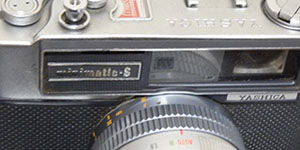
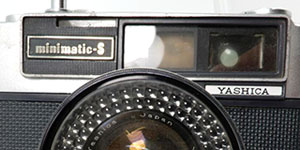
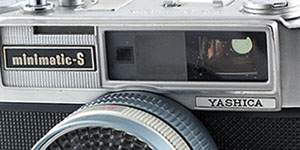
(Detail from larger web images)
The grey and most/all “black faces” feature an ASA scale with red coloured background, red ring on the film speed selector knob and red film plane symbol whereas the “white faces” feature a scale with black background and engraved knob and symbol without colour:
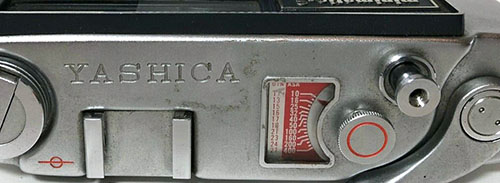
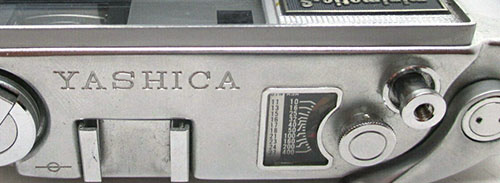 (Detail from larger web images)
(Detail from larger web images)
The serial number prefix for both models is “PA”. Found serial numbers for the S range from PA 303xxxx to PA 506xxxx (1963 March to 1965 June). Earlier cameras have the serial number on the back of the top plate, later cameras on top. A Minimatic-S from November 1963 is the last with the number on the back and first “white face” for that model, for the C, it seemed to arrive in 1964.
With both models but more so with the C than S, quite a few months feature 8 digit serial numbers instead of 7, i.e. 5 digit sequence numbers. For the explanation, see the Minister D above.
Finally, announced in December 1965 (“Yashica A, New Horizon” brochure) and released in February 1966, the first of the all new Yashica 35 mm cameras with electronic shutter and automatic exposure control, the Electro 35 models ushered in the electronic revolution for Yashica and large scale rangefinder success. Or did it?
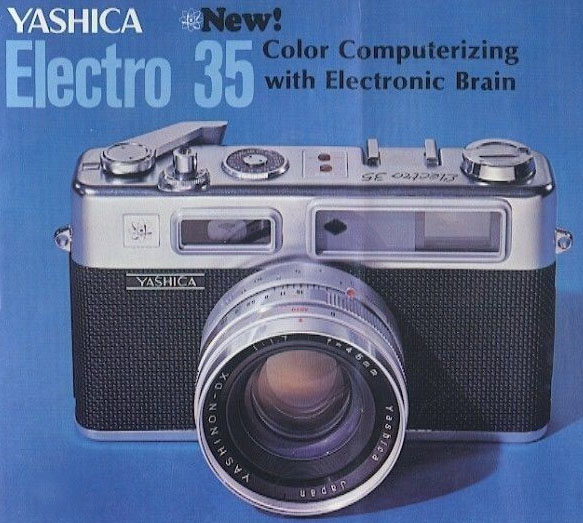
(From larger brochure page)
In fact, this probably wasn't the first Electro model. Earlier, I mentioned Yashica's half-frame models starting with the Rapide. A number of more conventional models followed based on similar feature sets to the full-frame cameras. Then the Yashica Electro Half was claimed to be released in 1965 (see link below). It was a more sophisticated version of the earlier selenium cell based Half 17. It featured similar electronics and automatic exposure to its larger sibling. The only thing it was missing is the electron logo, perhaps yet to be “invented”. Its earlier release date than the Electro 35 would make it the true leader of the electronic revolution.
I might add that Minolta “launched” (what does that mean, announced, released?) its similarly specified electronically controlled automatic exposure 35 mm rangefinder Electro Shot also in 1965, complete with the electron symbol usually associated with the Yashica Electro models. Someone suggested that the electron symbol belonged to Copal and its new electronically controlled shutters at the heart of the Yashica models but note, the Minolta Electro Shot shutter was a Seiko ES.
For the next step in Yashica rangefinder history, the Yashica Electro 35 page of the site, Camera Collector Pages, provides an excellent overview of the Electro 35 line including models time-line and feature sets.
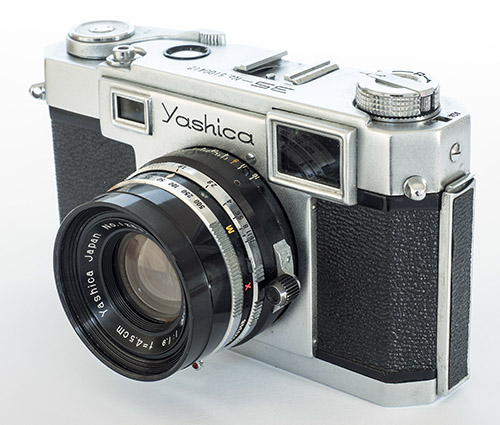
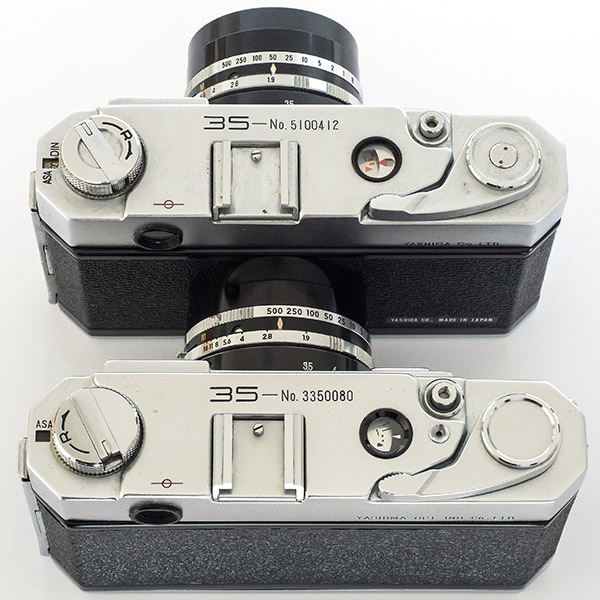
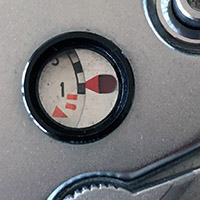

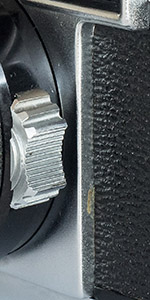
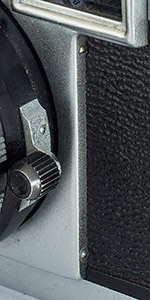


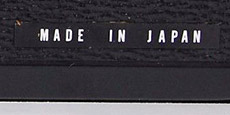
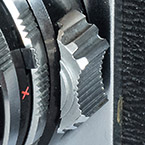
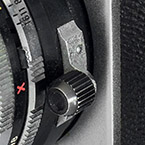
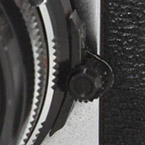
.jpg)
.jpg)